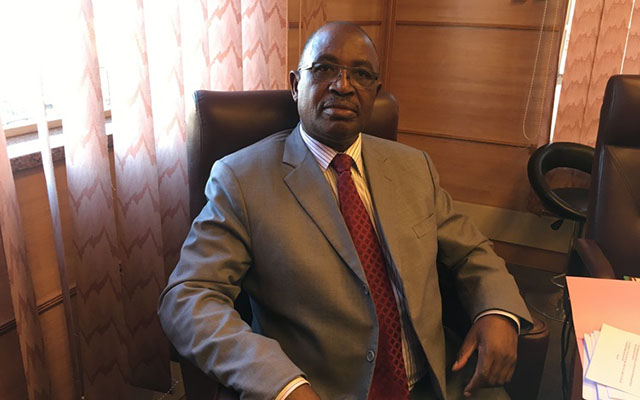‘Using kaylite endangers your health’


Ambassador Nsimbi . . . Here we have taken a position to say people must know and people must be protected
THE INTERVIEW Christopher Farai Charamba
CC: There is this ban on kaylite which has been imposed and one of the reactions from people is that it has come at short notice. Going by that, why has this ban suddenly been put forward?
ZN: The ban did not come at short notice. Let me give you the history of the kaylite problem. Kaylite started coming into Zimbabwe around 2009 at dollarisation. Before that, the problem wasn’t there.
In 2010, it became evident that this really is an environmental hazard and we engaged stakeholders and said “guys we have a problem with kaylite, let’s see what we can do.”
The stakeholders promised that they would start recycling, they would not continue to throw kaylite around. But that came to nowhere. There was no programme that came through, they promised and did not do anything.
In 2012, Government took the initiative, realising that the situation was getting worse, to put in place the Statutory Instrument 84 of 2012. That SI banned the manufacture and importation of kaylite into the country.
Again when the manufacturing instrument came into being, the stakeholders came back to us and said, “we need time, time to change our habits and come up with alternatives,” and they were given the time. But again, nothing happened.
By 2015, the Minister of Environment took the initiative and said “look, maybe if we give them a timeline and the period of when to comply, they would comply,” and the minster gave them six months moratorium.
Again, nothing happened. At the end of the six months, they were back again knocking at the door to say we still need more time. Still they didn’t do anything until about three or four months ago, when we had the results of research that came out of the University of Zimbabwe, which compelled EMA to say what’s happening?
Those results indicated that kaylite was a danger and a health hazard to people who are using it. They indicated that it breaks down at certain temperatures and a component of it in its gaseous form migrates into the food which has been put into the kaylite dish.
That’s when we said let’s move. We have had a statement by Government saying what is happening, why don’t you ban? So we had to comply, we decided and said let’s revoke the action of SI84 and put a ban in place. That is where we are.
CC: You said SI84 was of 2012 and that the stakeholders asked for extensions as of 2015, but were there serious efforts by EMA to ensure that there was a reduction in kaylite use between 2012 and now when you have imposed this ban?
ZN: There were serious efforts as indicated by the statements that the minister issued and indicated by the fact that we supported the research which was done at the UZ. At the end though, nothing came through and we have taken an action now.
CC: How are you going to enforce this action that you have taken?
ZN: Already officers are out in industry now, checking who has what, who has kaylite and using it. We are doing this in conjunction with the law enforcement agency, the police, because we don’t have arresting powers, but they do.
We are serious that if you use (kaylite) outside the agreed statutory you will be arrested and you will be brought to book.
CC: And what is the penalty that is going to be imposed on those found using these kaylites?
ZN: The SI defined the levels of penalty. They run from level 1 to level 14. Level 1 being about $30 and level 14 being about $5 000. Those penalties we leave to the justice system because those who are apprehended and arrested will have to be brought before the magistrate courts and the magistrates will determine what fine they should pay.
CC: An argument for kaylites is that they are cheap and easily accessible, what alternatives would you suggest for those who have been using kaylite so that they can change to something more environmentally friendly?
ZN: If we look at the food industry, you will find that Nando’s use papers, Chicken Licken use a form of biodegradable container. So the system is there, there are alternatives to kaylite.
CC: How do you respond to the complaints of cost effectiveness of kaylite as opposed to these systems?
ZN: Our target is not maximising profits for the food industry. Our target is to defend Zimbabweans. Our target is to raise the awareness of our people to the dangers that kaylite poses to them. Our target is to ensure those dangers are stopped.
CC: How much of an effect does poor service delivery in garbage collection and the problem of litter in Harare and elsewhere have on this kaylite issue? You find that a lot of the packaging is littered and there have been issues of poor garbage collection, especially in the capital city.
ZN: The delay in collection of garbage in Harare City, yes it’s a challenge and a problem. However, when littered kaylite is sitting there, it’s not affecting your health. It is when you put food into it and you eat that food, that’s when you are now vulnerable to health problems.
So the collection of garbage is a problem, but it doesn’t have much to do with the kaylite itself. You know that the collection of garbage is a mixture of all the rubbish that comes out of the households.
We are not fighting with leftover sadza which is sitting there not been collected by Harare City Council, but we are fighting about you using kaylite, putting food in it and giving it to my son to eat.
CC: But you mentioned that at certain temperatures the gases from the kaylite become toxic, now a lot of people, because garbage is not being collected, have resorted to burning it. Is that not also going to have adverse health effects on people?
ZN: That’s a problem which we want the City of Harare to solve by collecting the garbage timeously.
We all know burning is no good for the environment. It destroys the ozone layer, it is a thing that we do not encourage anybody to do.
We are working tirelessly with the City of Harare to try and see that they improve their ability to collect garbage. We have assisted in several areas where we have gone out and undertaken clean-up programmes within Harare. We have even gone ahead and hired some trucks to try and assist in moving the garbage from where it is.
CC: You mentioned the health effects of kaylite, would it not have been prudent for EMA to conduct awareness campaigns before this ban was put in effect? To inform the public and those who are using these kaylite packaging of the health effects and sensitise them to why they need to change?
ZN: By putting the SI84 in 2012, it was clear that it was a problem. Then it was highlighted that kaylite is a danger to people’s health and that was publicity enough. Here we have taken a position to say people must know and people must be protected.
The duty of Government is to protect its citizens and we are exercising that right delegated by the Ministry of Environment, Water and Climate. So we think there is adequate publicity. I have gone around telling people that it is your health that is in danger.
If you accept food that is in a kaylite container, you are endangering your own health.
So let us be conscious of our own health, let us be conscious of what to use in order to live longer.










Comments